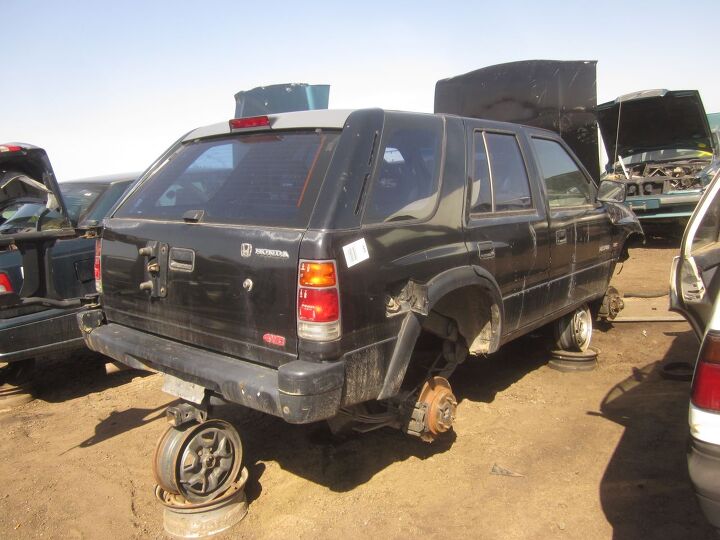The Nineties Return As Honda Revives 'Passport' Name: Report

The name of a long-defunct Honda-badged vehicle that was based on an Isuzu and built at a joint Isuzu-Subaru assembly plant will grace a new crossover, a report claims. Yes, it’s looking like Honda applied for a new Passport.
According to Automotive News, sources with knowledge of Honda’s product plans say the Nineties are indeed poised to return. The name will allegedly grace the brand’s upcoming two-row midsize crossover, slated to fill the space between the wildly popular CR-V and the range-topping Pilot.
One of the sources, citing dealer knowledge, claims Honda will show the vehicle to its dealer network in November ahead of a public debut at the Los Angeles Auto Show. The Passport’s on-sale date will arrive in early 2019.
Honda first offered the Passport in the U.S. market for the 1994 model year. The model, based on the Isuzu Rodeo, resulted from a vehicle-sharing deal struck between the two companies. Without any utility vehicles of its own, the Passport gave Honda a challenger to the likes of the Ford Explorer as the “family SUV” craze grew in popularity in Clinton-era America.
A second-generation Passport arrived for the 1998 model year. The model disappeared after 2002, not just because of GM’s increased control over the Isuzu brand, but because Honda had found its SUV sea legs.
In fielding a sub-Pilot-sized crossover, Honda adds a means to potentially poach buyers from the Hyundai Santa Fe Sport, Nissan Murano, and Ford Edge camps. And why shouldn’t it expect to? The Honda badge finds itself on several segment leaders. Even the brand’s littlest crossover, the HR-V, easily outsells other rivals in the subcompact segment.
Credit for the new model goes to Honda dealers, who apparently pressed HQ to come up with something more substantial than a CR-V. We came across a design patent granted last November that seems to show the next Passport. Built on the larger Pilot’s platform, the model looks like a cross between the defunct Honda Crosstour and the Ford Edge, and could find itself positioned as a near-premium vehicle.
If so, expect heaps of convenience and safety tech to go with the roomier two-row body. Without a doubt, there’ll be a turbocharged 2.0-liter four-cylinder found somewhere in the engine lineup. (That’s just too easy a bet these days.)
[Images: Murilee Martin/TTAC, U.S. Patent and Trademark Office ]

More by Steph Willems
Latest Car Reviews
Read moreLatest Product Reviews
Read moreRecent Comments
- ToolGuy No hybrid? No EV? What year is this? lolI kid -- of course there is an electric version.
- Tassos No, this is for sure NOT my favorite Caddy. Very few Caddys with big fins work out as designs.FOr interiors, I much prefer the Caddys and other US luxury cars from the 30s, Packards etc. After the war, they ditched the generous wood veneer (without which no proper luxury car) for either nothing or the worse than nothing fake wood.For exterior, I like many Caddys from the 60s and early 70s, when the fins slowly diminished and finally disappearedEven the current " Art and Science" angular styling is quite good and has lasted a quarter century (from the first CTS). They even look better than most Bangled BMWs and even some Mercs.- from outside only.
- ToolGuy Good for them.
- ToolGuy "I'm an excellent driver."
- Tassos If a friend who does not care about cars asks me what to buy, I tell her (it usually is a she) to get a Toyota or a Lexus. If she likes more sporty cars, a Honda or a MiataIf a friend is a car nut, they usually know what they want and need no help. But if they still ask me, I tell them to get a Merc or AMG, a 911, even an M3 if they can fix it themselves. If they are billionaires, and I Do have a couple of these, a Ferrari or an even more impractical Lambo.



































Comments
Join the conversation
And don't forget the (very) short-lived Canadian GM Passport brand. Basically a rebadged Daewoo/Opel Kadett. http://cartype.com/pics/7718/full/passport_optima_ad_86.jpg
I have it on good authority this will be more a shrunken Pilot than a Hondafied 2019 RDX, complete with J motor, not a turbo K.